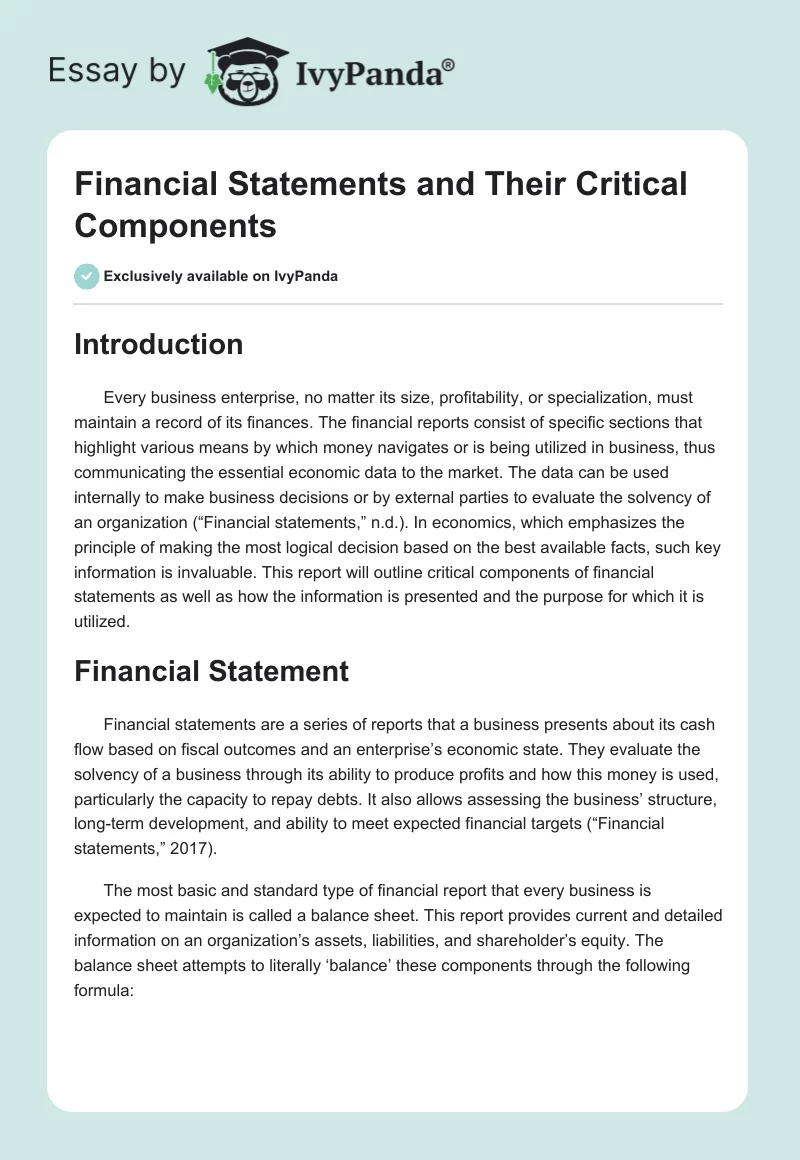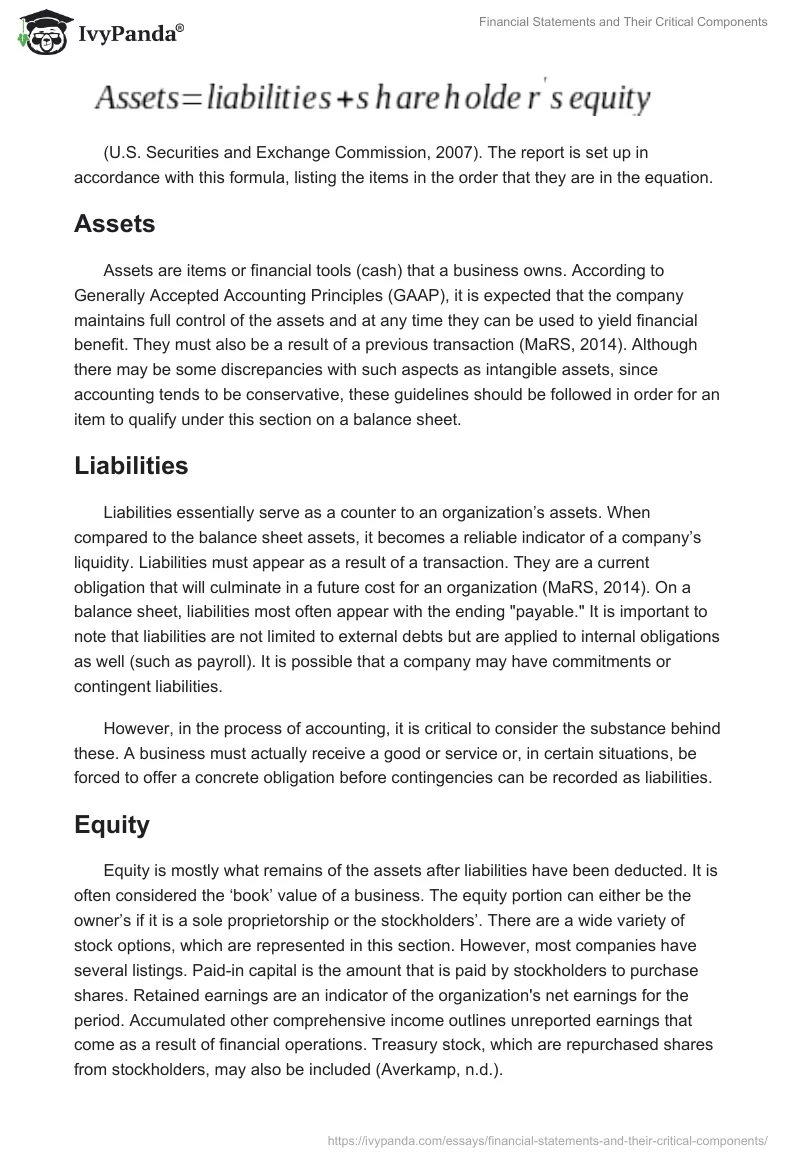Introduction
Every business enterprise, no matter its size, profitability, or specialization, must maintain a record of its finances. The financial reports consist of specific sections that highlight various means by which money navigates or is being utilized in business, thus communicating the essential economic data to the market. The data can be used internally to make business decisions or by external parties to evaluate the solvency of an organization (“Financial statements,” n.d.). In economics, which emphasizes the principle of making the most logical decision based on the best available facts, such key information is invaluable. This report will outline critical components of financial statements as well as how the information is presented and the purpose for which it is utilized.
Financial Statement
Financial statements are a series of reports that a business presents about its cash flow based on fiscal outcomes and an enterprise’s economic state. They evaluate the solvency of a business through its ability to produce profits and how this money is used, particularly the capacity to repay debts. It also allows assessing the business’ structure, long-term development, and ability to meet expected financial targets (“Financial statements,” 2017).
The most basic and standard type of financial report that every business is expected to maintain is called a balance sheet. This report provides current and detailed information on an organization’s assets, liabilities, and shareholder’s equity. The balance sheet attempts to literally ‘balance’ these components through the following formula:
(U.S. Securities and Exchange Commission, 2007). The report is set up in accordance with this formula, listing the items in the order that they are in the equation.
Assets
Assets are items or financial tools (cash) that a business owns. According to Generally Accepted Accounting Principles (GAAP), it is expected that the company maintains full control of the assets and at any time they can be used to yield financial benefit. They must also be a result of a previous transaction (MaRS, 2014). Although there may be some discrepancies with such aspects as intangible assets, since accounting tends to be conservative, these guidelines should be followed in order for an item to qualify under this section on a balance sheet.
Liabilities
Liabilities essentially serve as a counter to an organization’s assets. When compared to the balance sheet assets, it becomes a reliable indicator of a company’s liquidity. Liabilities must appear as a result of a transaction. They are a current obligation that will culminate in a future cost for an organization (MaRS, 2014). On a balance sheet, liabilities most often appear with the ending “payable.” It is important to note that liabilities are not limited to external debts but are applied to internal obligations as well (such as payroll). It is possible that a company may have commitments or contingent liabilities.
However, in the process of accounting, it is critical to consider the substance behind these. A business must actually receive a good or service or, in certain situations, be forced to offer a concrete obligation before contingencies can be recorded as liabilities.
Equity
Equity is mostly what remains of the assets after liabilities have been deducted. It is often considered the ‘book’ value of a business. The equity portion can either be the owner’s if it is a sole proprietorship or the stockholders’. There are a wide variety of stock options, which are represented in this section. However, most companies have several listings. Paid-in capital is the amount that is paid by stockholders to purchase shares. Retained earnings are an indicator of the organization’s net earnings for the period. Accumulated other comprehensive income outlines unreported earnings that come as a result of financial operations. Treasury stock, which are repurchased shares from stockholders, may also be included (Averkamp, n.d.).
Classified Balance Sheets
A classified balance sheet is commonly divided current assets and liabilities from long-term ones. This is done to indicate the time period in which the company is expected to cash in (for assets) or repay (liabilities) the items. The term current indicates that the listed items are relevant to the date of one year within the release of the balance sheet. Sometimes, it may be longer if the company’s operating cycle is over a year. Obviously, long-term represents anything past that due date. This division is also called splitting the balance sheet into ‘classifications,’ which can be used to identify and differentiate amongst complex categories, specifically large organizations (“Classified balance sheets,” n.d.).
Current assets are considered cash available in accounts, including checking and saving. Cash in the rotation of the company and accounts receivable are considered current. Prepaid insurance is credited on a monthly basis as it is paid. Finally, the physical inventory of products that could be sold is evaluated as an asset. Long-term assets are most often considered business owned land and buildings, the value of which is established based on the cost of purchase (without depreciation).
Other non-revolving properties such as vehicles, furniture, leasehold improvements, and equipment are all assets. Finally, intangible assets such as patents and copyrights are included, dependent on legal expiration dates. Current liabilities are immediate costs and debts that must be paid within 12 months. Standardly this includes accounts payable, wages, and tax. It may also include bank debts, notes payable, dividends, and leases. Long-term liabilities. Long-term liabilities usually include loan debts, mortgages, and deferred taxes, which are paid overtime (“Classified balance sheets,” n.d.).
Using the Information
Separating current or long-term assets and liabilities is a standard accounting norm. This information is critical in decision-making regarding business finances and operations. Management can use this information to evaluate the performance of a company and to build a long-term strategy. For example, if current liabilities are acceptable against a company’s assets, but significant long-term liabilities are accumulating, it may be necessary to cut costs and increase productivity in order for the business to stay profitable. The essential financial metrics provided by a classified balance sheet can provide a diagnostic tool that is used for organizational aspects and provides an indicator of the health of the business.
Meanwhile, creditors and external parties value this information to form their own evaluation of the business. Most often, creditors are interested in the solvency of the business, particularly in its ability to pay debts in the long-term. Classifications on the balance sheet present a direct outline of the company’s ability to repay, which is the primary aspect that creditors consider before approving a loan.
While the current profitability of a business may be of interest, creditors are inherently interested in whether a company maintains the necessary assets which can be used to collect a debt and whether other long-term liabilities will interfere with the process of repayment. Essentially, it is a well-established mechanism of risk evaluation that has been perfected by financial institutions to decide on business loans based on the provided information on a balance sheet.
References
Averkamp, H. (n.d.). Owner’s (stockholders’) equity. Web.
Classified balance sheets. (n.d.). Web.
Financial statements. (n.d.). Web.
Financial statements. (2017). Web.
MaRS. (2014). Reading a financial statement: The balance sheet (assets, liabilities and equity). Web.
U.S. Securities and Exchange Commission. (2007). Beginner’s guide to financial statements. Web.


